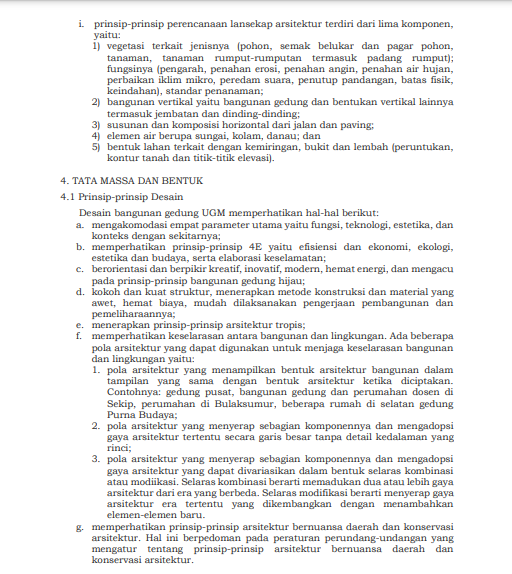Rules
- UGM Rector’s Decree on Technical Guidelines for UGM Building Code, Page 20


Landscape Principles related to plants. Vegetation related to type (trees, shrubs and hedges, plants, grasses including grasslands); function (directional, erosion control, windbreak, rainwater retention, microclimate improvement, sound dampening, view cover, physical boundary, beauty), planting standards.
- Guidelines for Vegetation Management at UGM

The rationale for the arrangement of vegetation at UGM is related to ecological considerations within the campus by taking into account the existence of the area, soil conditions, climatic conditions, and water supply.
Application of landscape plants
UGM Biological Forest
- Function of Biological Forest


The Biological Forest protects, recreates, and aesthetics and provides other functional benefits to urban communities, especially those in the UGM area.
- Types of plants in Biological Forest

In 1972, this Biological Forest was a medicinal garden. Over time, this forest was converted into a biological garden. About 91 species of plants grow in this Biological Forest UGM. Such as Asoka trees, mundu trees, meranti trees, Nagasaki trees, and range alas trees. There are iconic animals such as the Agapornis cana bird.
Arboretum Faculty of Forestry UGM
- About the arboretum

The arboretum, or small forest, was designed in 1971 by the ‘UGM Landscape Plan’ document, which contains the concept of open space arrangement. The philosophical meaning of the existence of the arboretum in the north of the campus Center Building describes a form of ‘service to the people’. From west to east depicts the archipelago, and from Bunderan to Gadjah Mada Forest depicts the journey of a scientist or scholar. The atmosphere is diverse: tunggal ika, then on the left and right resin trees, and so on until finally the bodhi tree, enlightened and Gadjah Mada Forest.
- Gadjah Mada Forest

The UGM Campus Bulaksumur Complex has been designed since 1950. Starting in the 1970s, UGM gradually moved from the Keraton and Ngasem campuses to the Bulaksumur Campus. The arrangement of the Bulaksumur campus area is regulated in the 1971 UGM Campus Landscape Plan, which contains the concept of structuring open spaces. One of them is the Arboretum, which is located to the north of the UGM Center Building. The forest is dominated by vegetation, able to create a microclimate compared to the outside climate
- Additional Archipelago Plants Planted in Arboretum Faculty of Forestry UGM

In 2023, coinciding with the 59th Anniversary of the Faculty of Forestry, the initiation of planting 13 types of trees aims to conserve and introduce various types of trees that grow on various islands in Indonesia, develop a culture of planting trees for the common good, and support government programs to reduce the impact of climate change.
References:
